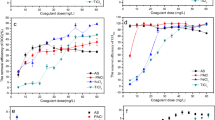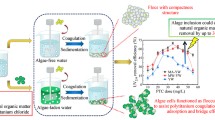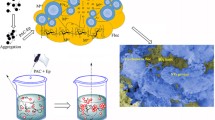Abstract
Algae and suspended colloidal particles produced high turbidity in water, weakened water purification, and threatened the safety of the water supply. In this study, a series of composite coagulants (atp-st-CTA) composed of a cationic starch (st-CTA) and attapulgite (ATP) with different fed mass ratios were fabricated by a simple method to coagulate kaolin suspension with initial turbidity of 80.0 NTU and Chlorella suspension with 0.25 mg/L of chlorophyll a (chla), respectively. Fourier transform infrared spectroscopy and scanning electron microscopy investigated the structural characteristics of atp-st-CTA. The maximum turbidity and chla removal rates of atp-st-CTA were 92.2% and 100.0%, respectively, at natural pH conditions. The effects of the fed mass ratio of st-CTA to ATP in the composites, dose, pH, and coexisting humic acid on the coagulation performance of atp-st-CTA were comprehensively investigated. Based on the apparent coagulation behaviors, the zeta potentials of the supernatants after coagulation, and the flocs properties, the coagulation mechanisms of atp-st-CTA were discussed in detail. The complete charge neutralization due to st-CTA and the enhanced sedimentation by ATP synergistically removed turbidity and algae from the water efficiently. In short, atp-st-CTA as a talented material has a notable prospect in applications of water treatment owing to its advantages of environmental friendliness, low cost, and high efficiency.
Similar content being viewed by others
References
Scherer L, Pfister S. Global biodiversity loss by freshwater consumption and eutrophication from swiss food consumption. Environ Sci Technol, 2016, 50: 7019–7028
Sinha E, Michalak A M, Balaji V. Eutrophication will increase during the 21st century as a result of precipitation changes. Science, 2017, 357: 405–408
Huisman J, Codd G A, Paerl H W, et al. Cyanobacterial blooms. Nat Rev Microbiol, 2018, 16: 471–483
Havens K E. Cyanobacteria blooms: Effects on aquatic ecosystems. Adv Exp Med Biol, 2008, 619: 733–747
Guo L. Doing battle with the green monster of Taihu lake. Science, 2007, 317: 1166
Cheng B, Xia R, Zhang Y, et al. Characterization and causes analysis for algae blooms in large river system. Sustain Cities Soc, 2019, 51: 101707–101717
Chang C L, Liao C S. Assessing the risk posed by high-turbidity water to water supplies. Environ Monit Assess, 2012, 184: 3127–3132
Undurraga R, Vicuña S, Melo O. Compensating water service interruptions to implement a safe-to-fail approach to climate change adaptation in urban water supply. Water, 2020, 12: 1540–1557
Ghernaout B, Ghernaout D, Saiba A. Algae and cyanotoxins removal by coagulation/flocculation: A review. Desalination Water Treatment, 2010, 20: 133–143
Li S, Hu T, Xu Y, et al. A review on flocculation as an efficient method to harvest energy microalgae: Mechanisms, performances, influencing factors and perspectives. Renew Sustain Energy Rev, 2020, 131: 110005–110019
Yang R, Li H, Huang M, et al. A review on chitosan-based flocculants and their applications in water treatment. Water Res, 2016, 95: 59–89
Wei H, Gao B, Ren J, et al. Coagulation/flocculation in dewatering of sludge: A review. Water Res, 2018, 143: 608–631
Hu C, Liu H, Qu J, et al. Coagulation behavior of aluminum salts in eutrophic water: Significance of Al13 species and pH control. Environ Sci Technol, 2006, 40: 325–331
Chen Z, Zhang W, Wang D, et al. Enhancement of activated sludge dewatering performance by combined composite enzymatic lysis and chemical re-flocculation with inorganic coagulants: Kinetics of enzymatic reaction and re-flocculation morphology. Water Res, 2015, 83: 367–376
Tepe Y, Çebi A. Acrylamide in environmental water: A review on sources, exposure, and public health risks. Expo Health, 2017, 11: 3–12
Ding S, Chu W, Bond T, et al. Contribution of amide-based coagulant polyacrylamide as precursors of haloacetamides and other disinfection by-products. Chem Eng J, 2018, 350: 356–363
Bemiller J N. Starch: Chenistry and Technology. New York: Academic Press, 2009. 354–364
Pal S, Mal D, Singh R P. Cationic starch: An effective flocculating agent. Carbohydrate Polyms, 2005, 59: 417–423
Vandamme D, Foubert I, Meesschaert B, et al. Flocculation of microalgae using cationic starch. J Appl Phycol, 2010, 22: 525–530
Liu Z, Wei H, Li A, et al. Evaluation of structural effects on the flocculation performance of a co-graft starch-based flocculant. Water Res, 2017, 118: 160–166
Ren J, Li N, Wei H, et al. Efficient removal of phosphorus from turbid water using chemical sedimentation by FeCl3 in conjunction with a starch-based flocculant. Water Res, 2020, 170: 115361
Hu P, Xi Z, Li Y, et al. Evaluation of the structural factors for the flocculation performance of a co-graft cationic starch-based flocculant. Chemosphere, 2020, 240: 124866–124876
Chittapun S, Jangyubol K, Charoenrat T, et al. Cationic cassava starch and its composite as flocculants for microalgal biomass separation. Int J Biol Macromolecules, 2020, 161: 917–926
Li Y, Zhang H, Wang X, et al. Preparation and flocculation performance of polysilicate aluminum-cationic starch composite flocculant. Water Air Soil Pollut, 2020, 231: 339–346
Ma J, Xia W, Fu X, et al. Magnetic flocculation of algae-laden raw water and removal of extracellular organic matter by using composite flocculant of Fe3O4/cationic polyacrylamide. J Cleaner Production, 2020, 248: 119276
Tang Y, Hu X, Cai J, et al. An enhanced coagulation using a starch-based coagulant assisted by polysilicic acid in treating simulated and real surface water. Chemosphere, 2020, 259: 127464
Lagaly G. Handbook of Clay Science. Amsterdam: Elsevier Sci, 2006. 266–289
Han H, Rafiq M K, Zhou T, et al. A critical review of clay-based composites with enhanced adsorption performance for metal and organic pollutants. J Hazard Mater, 2019, 369: 780–796
Yang R, Li D, Li A, et al. Adsorption properties and mechanisms of palygorskite for removal of various ionic dyes from water. Appl Clay Sci, 2018, 151: 20–28
Pan G, Zhang M M, Chen H, et al. Removal of cyanobacterial blooms in taihu lake using local soils. I. Equilibrium and kinetic screening on the flocculation of microcystis aeruginosa using commercially available clays and minerals. Environ Pollut, 2006, 141: 195–200
Wu H, Liu Z, Yang H, et al. Evaluation of chain architectures and charge properties of various starch-based flocculants for flocculation of humic acid from water. Water Res, 2016, 96: 126–135
Li H, Cai T, Yuan B, et al. Flocculation of both kaolin and hematite suspensions using the starch-based flocculants and their floc properties. Ind Eng Chem Res, 2015, 54: 59–67
Jespersen A M, Christoffersen K. Measurements of chlorophyll-a from phytoplankton using ethanol as extraction solvent. Archiv Fur Hydrobiol, 1987, 109: 445–454
Chakraborti R K, Gardner K H, Atkinson J F, et al. Changes in fractal dimension during aggregation. Water Res, 2003, 37: 873–883
Naushad M, Ahamad T, Sharma G, et al. Synthesis and characterization of a new starch/SnO2 nanocomposite for efficient adsorption of toxic Hg2+ metal ion. Chem Eng J, 2016, 300: 306–316
Wang Y, Feng Y, Zhang X F, et al. Alginate-based attapulgite foams as efficient and recyclable adsorbents for the removal of heavy metals. J Colloid Interface Sci, 2018, 514: 190–198
Bratby J. Coagulation and Flocculation in Water and Wastewater Treatment. 3rd ed. London: IWA Publishing, 2016. 247–282
Pivokonsky M, Naceradska J, Brabenec T, et al. The impact of interactions between algal organic matter and humic substances on coagulation. Water Res, 2015, 84: 278–285
Huang M, Wang Y, Cai J, et al. Preparation of dual-function starch-based flocculants for the simultaneous removal of turbidity and inhibition of escherichia coli in water. Water Res, 2016, 98: 128–137
Liu Z, Huang M, Li A, et al. Flocculation and antimicrobial properties of a cationized starch. Water Res, 2017, 119: 57–66
Ursu A V, Marcati A, Sayd T, et al. Extraction, fractionation and functional properties of proteins from the microalgae chlorella vulgaris. Bioresource Tech, 2014, 157: 134–139
Mbey J A, Thomas F, Razafitianamaharavo A, et al. A comparative study of some kaolinites surface properties. Appl Clay Sci, 2019, 172: 135–145
Falayi T, Ntuli F. Removal of heavy metals and neutralisation of acid mine drainage with un-activated attapulgite. J Indust Eng Chem, 2014, 20: 1285–1292
Brady P V, Pohl P I, Hewson J C. A coordination chemistry model of algal autoflocculation. Algal Res, 2014, 5: 226–230
Bratskaya S, Schwarz S, Chervonetsky D. Comparative study of humic acids flocculation with chitosan hydrochloride and chitosan glutamate. Water Res, 2004, 38: 2955–2961
Tan L, Tan X, Ren X, et al. Influence of pH, soil humic acid, ionic strength and temperature on sorption of U(VI) onto attapulgite. J Radioanal Nucl Chem, 2018, 316: 981–991
Wu Z, Zhang X, Pang J, et al. Humic acid removal from water with PAC-Al30: Effect of calcium and kaolin and the action mechanisms. ACS Omega, 2020, 5: 16413–16420
Yin Z, Li S, Hu D, et al. Performance evaluation of different chitosanclay composite materials for efficient harvesting of chlorella vulgaris and impacts on downstream bioproduct processing and water reusability. Chem Eng J, 2022, 430: 132892
Author information
Authors and Affiliations
Corresponding author
Additional information
This work was supported by the National Natural Science Foundation of China (Grant Nos. 42061144014 and 51978325) and the Quanzhou City Science & Technology Program of China (Grant No. 2021CT001).
Supporting Information
The supporting information is available online at tech.scichina.com and link.springer.com. The supporting materials are published as submitted, without typesetting or editing. The responsibility for scientific accuracy and content remains entirely with the authors.
Supporting Information
11431_2022_2123_MOESM1_ESM.pdf
Efficient removal of algae and turbidity from water by a composite coagulant composed of a cationic starch and attapulgite
Rights and permissions
About this article
Cite this article
Jin, J., Xia, W., Hu, P. et al. Efficient removal of algae and turbidity from water by a composite coagulant composed of a cationic starch and attapulgite. Sci. China Technol. Sci. 65, 2979–2989 (2022). https://doi.org/10.1007/s11431-022-2123-3
Received:
Accepted:
Published:
Issue Date:
DOI: https://doi.org/10.1007/s11431-022-2123-3




